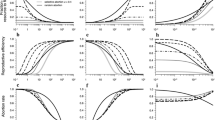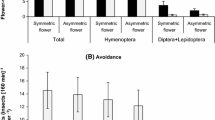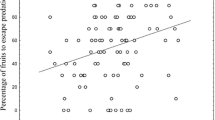Abstract
Many plants produce excessive flowers and several hypotheses have been proposed for adaptive significances of this behavior. Here, I develop a simple resource allocation model for plants in a mutualism with pollinating seed-predators to examine a novel hypothesis that excessive flower production can be favored to “dilute” seed predation by the pollinators. Pollinators visit flowers to deposit pollen and oviposit on them, and their offspring feed on a portion of the seeds, leaving the remainder intact. Further pollinator visits increase seed mortality by over-oviposition. Excessive flower production is favored if it decreases pollinator-visit frequency per flower, while it incurs decrease in seed production because of the resource trade-off. I examine three plant strategies: (1) no abortion, the plant allocates resource to all pollinated flowers to mature; (2) selective abortion, the plant aborts flowers depending on how many times they were visited by pollinators; and (3) random abortion, the plant indiscriminately aborts a fraction of pollinated flowers irrespective of how many times they were visited. I show that the random abortion strategy can perform much more effectively than the no-abortion strategy when the amount of resource is small, the production cost per flower is low, and the pollinator density is high, although the selective abortion strategy is always the best. This “predator dilution” effect has not been considered with regard to previous excessive flower production hypotheses.




Similar content being viewed by others
References
Addicott JF, Bao T (1999) Limiting the costs of mutualism: multiple modes of interaction between yuccas and yucca moths. Proc R Soc Lond B Biol Sci 266:197–202
Bull JJ, Rice WR (1991) Distinguishing mechanisms for the evolution of co-operation. J Theor Biol 149:63–74
Burkhardt A, Delph LF, Bernasconi G (2009) Benefits and costs to pollinating, seed-eating insects: the effect of flower size and fruit abortion on larval performance. Oecologia 161:87–98
Dufaÿ M, Anstett MC (2003) Conflicts between plants and pollinators that reproduce within inflorescences: evolutionary variations on a theme. Oikos 100:3–14
Ghazoul J, Satake A (2009) Nonviable seed set enhances plant fitness: the sacrificial sibling hypothesis. Ecology 90:369–377
Holland JN, DeAngelis DL (2001) Population dynamics and the ecological stability of obligate pollination mutualisms. Oecologia 126:575–586
Holland JN, DeAngelis DL (2002) Ecological and evolutionary conditions for fruit abortion to regulate pollinating seed-eaters and increase plant reproduction. Theor Popul Biol 61:251–263
Holland JN, DeAngelis DL (2006) Interspecific population regulation and the stability of mutualism: fruit abortion and density-dependent mortality of pollinating seed-eating insects. Oikos 113:563–571
Holland JN, Bronstein JL, DeAngelis DL (2004a) Testing hypotheses for excess flower production and low fruit-to-flower ratios in a pollinating seed-consuming mutualism. Oikos 105:633–640
Holland JN, DeAngelis DL, Schultz ST (2004b) Evolutionary stability of mutualism: interspecific population regulation as an evolutionarily stable strategy. Proc R Soc Lond B Biol Sci 271:1807–1814
Huth CJ, Pellmyr O (2000) Pollen-mediated selective abortion in yuccas and its consequences for the plant–pollinator mutualism. Ecology 81:1100–1107
Janzen DH (1971) Seed predation by animals. Ann Rev Ecol Evol Syst 2:465–492
Janzen DH (1978) Seedling patterns of tropical trees. In: Tomlinson PB, Zimmermann MH (eds) Tropical trees as living systems. Cambridge University Press, Cambridge, pp. 83–128
Janzen DH (1979) How to be a fig. Ann Rev Ecol Evol Syst 10:13–51
Kelly D (1994) The evolutionary ecology of mast seeding. Trends Ecol Evol 9:465–470
Kiers ET, Denison RF (2008) Sanctions, cooperation, and the stability of plant–rhizosphere mutualisms. Ann Rev Ecol Evol Syst 39:215–236
Kiers ET, Rousseau RA, West SA, Denison RF (2003) Host sanctions and the legume–rhizobium mutualism. Nature 425:78–81
Pellmyr O, Huth CJ (1994) Evolutionary stability of mutualism between yuccas and yucca moths. Nature 372:257–260
Sakai S (2007) A new hypothesis for the evolution of overproduction of ovules: an advantage of selective abortion for females not associated with variation in genetic quality of the resulting seeds. Evolution 61:984–993
Shapiro J, Addicott JF (2004) Re-evaluating the role of selective abscission in moth/yucca mutualisms. Oikos 105:449–460
Smith CC, Fretwell SD (1974) The optimal balance between size and number of offspring. Am Nat 108:499–506
Stephenson AG (1981) Flower and fruit abortion: proximate causes and ultimate functions. Ann Rev Ecol Evol Syst 12:253–279
Traveset A (1993) Deceptive fruits reduce seed predation by insects in Pistacia terebinthus L. (Anacardiaceae). Evol Ecol 7:357–361
Udovic D, Aker C (1981) Fruit abortion and the regulation of fruit number in Yucca whipplei. Oecologia 49:245–248
Zangerl AR, Berenbaum MR, Nitao JK (1991) Parthenocarpic fruits in wild parsnip: decoy defense against a specialist herbivore. Evol Ecol 5:136–145
Acknowledgments
I thank Yusuke Ikegawa and Koichi Ito for their valuable comments. This work was supported by the Grant-in-Aid for Scientific Research (C) from the Japan Society for the Promotion of Science (JSPS) KAKENHI 23570034.
Author information
Authors and Affiliations
Corresponding author
Appendices
Appendix A: The case that viable seeds are left in flowers visited more than once
Here, I assume that flowers visited by pollinators more than once can contain viable seeds, other assumptions remaining the same as in the “Mathematical model and analysis” section.
The equation of resource constraint for the selective abortion plant is
where P i is the probability that a flower on the plant is visited i times,
The variable u i (i = 2, 3,...) is the abortion rates of flowers visited i times. The equations of resource constraint for no abortion and random abortion plants are Eq. 1a and 1c, respectively.
The reproductive successes of the three strategy plants are
instead of Eq. 3a, 3b, and 3c, respectively. The variable q i (i = 1, 2,...) is the mean fraction of intact seeds in a flower visited by pollinators i times. It is reasonable to assume that q i decreases as i increases as far as it is positive.
If the selective abortion plant regulates the abortion rates to optimize their reproductive success, the plant should preferentially abort flowers visited more by pollinators (i.e., containing less viable seeds) to allocate resource to flowers visited less (containing more viable seeds). Therefore, (1) u i should be equal to one if q i is equal to zero, because plant should not allocate the resource to flowers containing no viable seeds, and (2) u i+1 should be equal to one if 0 < u i ≤ 1, because it is not adaptive for the plant to allocate the resource to flowers visited i + 1 times while it aborts (a part of) flowers visited i times.
However, in general, it is complicated to calculate an optimal set {u i } for the selective abortion strategy. Hereafter, I concentrate on the case of q 2 > 0 and q i = 0 for i > 3, in which Eq. 6b includes a single variable u 2. Applying the Lagrange multiplier method, I determine the optimal flower number n = n 2 * and abortion rate of twice-visited flowers u 2 * for the selective abortion strategy (Appendix B).
I also calculate the flower number n = n 1 * for the no-abortion strategy from Eq. 1a, and the optimal flower number n = n 3 * and abortion rate w 3 * for the random abortion strategy from Eq. 1c and Eq. 6c (Appendix C).
The results are shown in Figs. 5, 6, and 7. On the whole, most results are qualitatively the same as in the case that q 2 = 0. For the selective abortion strategy, however, the fraction of resource to flower production increases as u 2 * increases from zero to one (Figs. 5a, 6a, and 7a), which does not change the order of the three strategies in reproductive success (Figs. 5b, 6b, and 7b). The variable u 2 * is equal to one when the total amount of resource R and the cost of flower production f is small, and the density of pollinators a is high, while it is equal to zero when R and f are large and a is low (Figs. 5, 6, and 7). Note that the selective abortion strategy plant produces more flowers (Fig. 5a, 6a, and 7a) and enjoys higher reproductive efficiency (Fig. 5b, 6b, and 7b) than the no-abortion plant even when u 2 * = 0, because the selective abortion plant abort all flowers visited more than three times, while the no-abortion plant does not abort any flowers.
Dependence of no abortion (gray bold lines), selective abortion (broken lines), and random abortion (solid lines) on the total amount of resource R when q 2 > 0. a Fraction of resource allocated to flower production. b The reproductive efficiency. Shaded regions indicate the intervals where optimal abortion rate of twice-visited flowers for the selective abortion plant 0 < u 2 * < 1. Other parameter values are a = 40, f = 0.01, s = 0.04, k = 0.4, q 1 = 0.5, and q 2 = 0.3
Dependence of no abortion (gray bold lines), selective abortion (broken lines), and random abortion (solid lines) on production cost per flower f when q 2 > 0. a Fraction of resource allocated to flower production. b The reproductive efficiency. Other parameter values are identical to those in Fig. 5, except that R = 10
Dependence of no abortion (gray bold lines), selective abortion (broken lines), and random abortion (solid lines) on pollinator density a when q 2 > 0. a Fraction of resource allocated to flower production. b Reproductive efficiency. Other parameter values are identical to those in Fig. 5, except that R = 5
Appendix B: Derivation of optimal flower number and abortion rate in selective abortion when q 2 > 0
When q 2 > 0 and q i = 0 (i ≥ 3), the following function can be obtained from Eq. 5 and 6b:
where μ is a Lagrange multiplier. From Eq. 7, we have
and
From Eq. 9, we have μ = Qq 2 /s. Putting this into Eq. 6b and Eq. 8 and solving them simultaneously, we have the optimal number of flowers n = n 2 * and abortion rate of twice-visited flowers u 2 = u 2 *.
By definition, however, u 2 should be in the interval [0, 1]. If the value of u 2 * calculated above is out of the interval, we solve Eq. 5 with putting u 2 = 0 and u 2 = 1 with respect to n and put the solutions into Eq. 6b. The value of u 2 yielding the larger reproductive success ϕ 2 is the optimal abortion rate u 2 = u 2 *.
Appendix C: Derivation of optimal flower number and abortion rate in random abortion
First, the following function can be obtained from Eq. 1c and Eq. 6c:
where λ is a Lagrange multiplier. The following derivatives can be obtained:
and
and
Putting Eq. 13 and Eq. 14 into Eq. 11, we have an equation of the condition for the optimal flower number n = n 3 *, which we can solve numerically. The optimal abortion rate w 3 = w 3 * can then be calculated by putting n = n 3 * into Eq. 13.
By definition w 3 should be in the interval [0, 1]. If the value of w 3 * calculated above is out of the interval, the value of w 3 that maximizes ϕ 3 should be zero, because ϕ 3 is always equal to zero when w 3 = 1. In the case w 3 * = 0, the plant does not abort any pollinated flowers, and the random abortion strategy is the same as the no-abortion one.
Especially when q 1 = q > 0 and q i = 0 (i ≥ 2), the condition for n = n 3 * is
Note that n 3 * is independent of s and q, because Eq. 15 is independent of these parameters. In addition, w 3 * is independent of q, because Eq. 13 and Eq. 15 are independent of it. Moreover, when the number of pollinator visits to a plant is independent of the number of flowers (k = 0), V(n) = a and Eq. 15 is equivalent to
Thus, in this case, w 3 * = 1 − R/(as), which is independent of f.
Rights and permissions
About this article
Cite this article
Ezoe, H. Optimal resource allocation model for excessive flower production in a pollinating seed-predator mutualism. Theor Ecol 10, 105–115 (2017). https://doi.org/10.1007/s12080-016-0316-x
Received:
Accepted:
Published:
Issue Date:
DOI: https://doi.org/10.1007/s12080-016-0316-x







